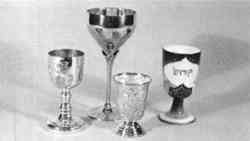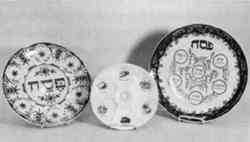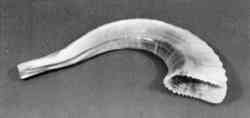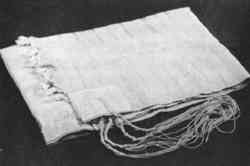“ACCESSORIES OF HOLINESS”: DEFINING JEWISH SACRED OBJECTSVIRGINIA GREENE
3 OTHER RITUAL OBJECTSThe second category of ritual objects is termed tashmishey mitzvah, “accessories of religious observance,” or, more clearly, “objects which make it possible to perform a commandment.” This category includes most other ritual object essential to Jewish life, including wine cups used on Sabbaths and holidays (fig. 8);4 the Hanukkah menorah (hanukiyah, fig. 9); seder plates used on Passover (fig. 10); the shofar (ram's horn trumpet, fig. 11); the tallit (a prayer shawl with special knotted fringes, called tzitzit, (fig. 12); the sukkah (booth), a temporary dwelling built on the holiday of Sukkot as well as the lulav (a palm branch tied together with willow and myrtle) and etrog (citron) also used on Sukkot, etrog containers; Sabbath candlesticks; the spice box and candle holder used for the Havdalah service at the end of the Sabbath; challah and matzah covers; wedding canopies.
Most of these are permanent and often passed on for generations. Those associated with Sukkot (with the exception of the etrog container) are impermanent and must be built or acquired anew each year. At the conclusion of Sukkot, the sukkah is dismantled. Though some of the Other tashmishey mitzvah may be also discarded when they are no longer fit for ritual use. If a ceramic seder plate breaks or a silver wine cup is crushed, it will be repaired (for use or display) if not too badly damaged (as any secular item of value), or if not repairable, it will be discarded and replaced. A wine-stained challah or matzah cover will be saved if embroidered by one's grandmother, discarded and replaced if a modern commercial product. A shofar, however, may not be repaired. A small chip at the bottom of the horn can be trimmed down, but if there is major damage to the mouthpiece or body of the horn it must be replaced. These objects may be discarded because they have no intrinsic quality of holiness. Great care and expense often go into their manufacture, so that they are objects of beauty (and hence of value in terms of Western aethetics), but this is a consequence of the principle of hiddur mitzvah, “enhancing a commandment” (derived from Exodus 15.2). It is desirable, for example, to have the most beautiful kiddush cup that one can afford, but if one cannot afford silver, then glass will serve, and if a fine wine glass is unavailable, then one puts the wine in a plain glass—or a Over centuries, however, customary practice has become stricter than the original law, and several of the objects in this group are now treated as tashmishey kedusha. The best example is the tallit. It is clear that merely untying the knots or cutting the cords removes all special qualities from the tzitzit (Mishneh Torah, II 8.9), and the tallit itself was not special at all, as it was originally an ordinary garment. By the 16th century, the custom had already changed. The Shulchan Arukh states that tzitzit “should be treated with the consideration due to holy objects” (Klein 1979:5, O.H. 15.1, 21.1). Today most Conservative synagogues will set aside for burial any synagogue tallit that is no longer fit to be worn, and traditional Jews will do the same with their own, as well as with a damaged shofar. These objects may be treated by any qualified objects or textiles conservator, with the same preference for minimal treatment noted above. No attempt should be made, however, to retie or replace damaged fringes on a tallit. |




